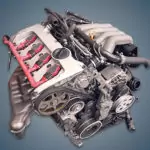The 1.6-liter 8-valve VW AHL engine was produced in Germany from 1996 to 2000 and was installed in only two models: the Volkswagen Passat B5 and the similar Audi A4 B5. The unit with the AHL index became the first longitudinal engine in the EA113 family.
The EA113-1.6 series includes: AEH, AHL, AKL, ALZ, ANA, APF, ARM, AVU, BFQ, BGU, BSE, BSF.
In 1996, on the Audi A4 and Passat B5 models, a 1.6-liter EA113 series engine appeared, which replaced the similar EA827 engine with a cast-iron cylinder block. By design, this unit has an in-line aluminum cylinder block with cast-iron liners, an aluminum 8-valve cylinder head equipped with hydraulic lifters, a timing belt drive. Finally, the intermediate shaft was removed and the distributor was replaced by a two-pin ignition coil.
In 1998, this engine was upgraded and instead of an aluminum intake manifold, it received a plastic one with a geometry change system, and its torque increased by 5 Nm.
Specifications
| Production years | 1996-2000 |
| Displacement, cc | 1595 |
| Fuel system | injector |
| Power output, hp | 100 |
| Torque output, Nm | 145 |
| Cylinder block | aluminum R4 |
| Block head | aluminum 8v |
| Cylinder bore, mm | 81 |
| Piston stroke, mm | 77.4 |
| Compression ratio | 10.2 |
| Features | SOHC |
| Hydraulic lifters | yes |
| Timing drive | belt |
| Phase regulator | no |
| Turbocharging | no |
| Recommended engine oil | 5W-30 |
| Engine oil capacity, liter | 4.0 |
| Fuel type | petrol |
| Euro standards | EURO 2/3 |
| Fuel consumption, L/100 km (for VW Passat B5 1998) — city — highway — combined |
11.2 6.0 7.9 |
| Engine lifespan, km | ~400 000 |
The engine was installed on:
- Audi A4 B5 (8D) in 1996 – 2000;
- Volkswagen Passat B5 (3B) in 1996 – 2000.
Disadvantages of the VW AHL engine
- The most famous problem of power units of this family is oil consumption, which usually appears after 150 – 200 thousand km and only increases with mileage. The reason is standard – this is the wear of the valve stem seals and the occurrence of piston rings.
- The main culprits for the unstable operation of this engine are clogged nozzles, a faulty gas pump or fuel pressure regulator, a crack in the ignition coil, glitches in the mass air flow sensor, and for versions with an intake geometry change system, the drive may wedge.
- Oil usually enters the cooling system due to a weak heat exchanger gasket, but there are enough cases of breakdown of the cylinder head gasket and the appearance of cracks in the cylinder head from overheating. Also, sometimes the aluminum block cracks in the area of the third and fourth cylinders.
- Lubrication leaks occur regularly, as well as antifreeze, especially if the crankcase ventilation system is clogged. Usually the plastic tee of the cooling system cracks here. The exhaust manifold often bursts, and when the timing belt breaks, the valves almost always bend.






